| Clinical Publications |
Scientific Publications |
| December 2024 |
Warm autoimmune hemolytic anemia as first presentation of chronic myeloid leukemia: A Case Report
Tawalbeh A et al. Case Rep Oncol, December 2024
– open access publication
|
Extracellular vesicle-mediated regulation of imatinib resistance in chronic myeloid leukemia via the miR-629-5p/SENP2/PI3K/AKT/mTOR axis
Jiang Y et al. Hematology, December 2024 – open access publication
|
Chronic myeloid leukemia treatment (PDQ): Health Professional Version. Review
PDQ Adult Treatment Editorial Board, December 2024
|
Critical role of protein kinase CK2 in chronic myeloid leukemia cells harboring the T3I5I BCR::ABL-1 mutation
Quezada Meza CP et al. Int J Biol Macromol, December 2024
(epub ahead of print)
– open access publication
|
An important oversight in the World Health Organization diagnostic classification: Chronic myeloid leukemia with the PML::RARA fusion clone
Wang J et al. Haematologica, December 2024
– open access publication
|
Febuxostat enhances the efficacy of dasatinib by inhibiting ATP-binding cassette subfamily G member 2 (ABCG2) in chronic myeloid leukemia cells
Kawashima K et al. Biomed Pharmacother, December 2024
– open access publication |
|
Successful pregnancy and delivery after frozen-thawed embryo transfer following a third discontinuation of tyrosine kinase inhibitors in a women with chronic myeloid leukemia
Takayama K et al. Int Med, December 2024 – open access publication
|
Targeting the insulin-like growth factor-1 to overcome imatinib resistance in chronic myeloid leukemia
Okabe S et al. Discov Mol, December 2024 – open access publication |
Asciminib in newly diagnosed chronic myeloid leukemia. Reply.
Hochhaus A et al. N Engl J Med, December 2024 |
Novel antileukemic compound with sub-micromolar potency against STAT5 addicted myeloid leukemia cells
Polamski M et al. Eur J Med Chem, December 2024 (epub ahead of print)
– open access publication
|
Asciminib add-on to imatinib demonstrates sustained high rates of ongoing therapy and deep molecular responses with prolonged follow-up in the ASC4MORE study
Hughes TP et al. J Hematol Oncol, December 2024
– open access publication |
Synergistic effects of inecalcitol with imatinib and dasatinib on chronic myeloid leukemia cell lines
Angel S et al. Anticancer Res, December 2024 – open access publication
|
The effect of body mass index on the safety of bosutinib in patients with chronic myeloid leukemia:
A post hoc pooled data analysis
Isfort S et al. Leuk Res, December 2024 |
Bortezomib induces cell apoptosis and increases the efficacy of alpha PD-1 in BCR:::ABL T3I5I mutation CML by targeting UBE2Q1
Jiang F et al. Int Immunopharmacol, December 2024
|
Advanced-stage chronic myeloid leukemia: Options for difficult treatment situations – Review
Atallah E and Deininger M. Drugs, December 2024 (epub ahead of print) |
Quantitative detection of T3151 mutations of BCR::ABL1 using digital droplet polymerase chain reaction
Mu H et al. Hematol Transfus Cell Ther, December 2024
– open access publication
|
Novel treatment strategies for chronic myeloid leukemia
Cruz-Rodriguez N and Deininger M. Blood,
December 2024 (epub ahead of print) |
Correlation analysis of bone marrow microvessel density and miRNA expression on drug resistance in patients with chronic myeloid leukemia after tyrosine kinase inhibitor treatment
Guo YG et al. Hematology, December 2024
– open access publication |
Mutation of epigenetic regulators at diagnosis is an independent predictor of tyrosine kinase inhibitor treatment failure in chronic myeloid leukemia: A Report from the RESIDIAG Study
Guerineau H et al. Am J Hematol, December 2024 (epub ahead of print) – open access publication |
BCR::ABL1-induced mitochondrial morphological alterations as a potential clinical biomarker in chronic myeloid leukemia
Suzuki K et al. Cancer Si, December 2024
– open access publication |
Safety and efficacy of flumatinib as later-line therapy in patients with chronic myeloid leukemia
Yang Y et al. Haematologica, December 2024
– open access publication |
|
Understanding and overcoming resistance to tyrosine kinase inhibitors (TKIs) in chronic myeloid leukemia (CML) - Review
Lagana A. at al. Expert Rev Hematol, December 2024 (epub ahead of print) |
|
Temporal effect of imatinib adherence on time to remission in chronic myeloid leukemia patients
Clark SE et al. J Oncol Pharm Pract, December 2024 |
|
Is there really an accelerated phase of chronic myeloid leukemia at presentation?
Yang S et al. Leukemia, December 2024
(epub ahead of print)
– open access publication |
|
| November 2024 |
|
Correction: Chronic myeloid leukemia diagnosed in pregnancy: management and outcome of 87 patients reported to the European LeukemiaNet International registry
Chelycheva E et al. Leukemia, November 2024
– open access publication
|
Investigating the role of non-synonymous variant D67N of ADGRE2 in chronic myeloid leukemia
Afzal A et al. BMC Cancer, November 2024
– open access publication
|
Safety and efficacy of asciminib in a patient with chronic myeloid leukemia on hemodialysis
Naka R et al. Int J Hematol, November 2024 (epub ahead of print) |
Targeting DDX3X eliminates leukemia stem cells in chronic myeloid leukemia
by blocking NT5DC2 mRNA translation
Duan C et al. Oncogene, November 2024 (epub ahead of print) |
Arterial occlusive events in a patient with chronic myeloid leukemia treated with ponatinib
Imataki O and Uemura M. Clin Case Rep,
November 2024
– open access publication
|
Chronic inflammation deters natural killer cell fitness and cytotoxicity in myeloid leukemia
Kuznetsova V et al. Blood Adv, November 2024 (epub ahead of print) |
Olverembatinib after failure of tyrosine kinase inhibitors, including ponatinib and asciminib: A phase 1b randomized clinical trial
Jabbour E et al. JAMA Oncol, November 2024 (epub ahead of print) |
Investigation of TSRP reverse imatinib resistance through the PI3K/Akt pathway in chronic myeloid leukemia
He Y et al. Ann Hematol, November 2024 (epub ahead of print)
|
Asciminib monotherapy as frontline treatment of chronic-phase chronic myeloid leukemia: results from the ASCEND Study
Yeung DT et al. Blood, November 2024 |
Enhanced induction of apoptosis in chronic myeloid leukemia cells through synergistic effect of telomerase inhibitor MST-312 on imatinib
Karami N et al. Nol Biol Rep,
November 2024
|
Long-term outcomes of tyrosine kinase inhibitors in chronic myeloid leukemia
Guilhot F and Hehlmann R. Blood, November 2024
(epub ahead of print) |
Single-cell multiomics analysis of chronic myeloid leukemia links cellular heterogeneity to therapy response
Warfvinge R et al. eLife, November 2024
– open access publication |
Dose modifications in the management of chronic phase chronic myeloid leukemia: Who, what, and when - Review
Oehler VG et al. J Natl. Compr Canc Netw,
November 2024
– open access publication |
Immune checkpoints PD1/PDL1, TIM3/GAL9 and key immune mediators landscape reveal differential expression dynamics on imatinib response in chronic myeloid leukemia
Toloza MY et al. Ann Hematol, November 2024
(epub ahead of print) |
Loss in overall and quality-adjusted life expectancy for patients with chronic-phase chronic myeloid leukemia
Chen EY et al. Eur J Haematol, November 2024
(epub ahead of print)
– open access publication |
A novel next generation sequencing assay for the identification of BCR::ABL1 transcript type and accurate and sensitive detection of TKI-resistant mutations
Yan Z et al. J Appl Lab Med, November 2024 |
Real-world toxicity and efficacy of asciminib in heavily pretreated patients with chronic myeloid leukemia
Ishii Y et al. Int J Haematol, November 2024
(epub ahead of print) |
The CML experience to elucidate the role of innate T-cells as effectors in the control of residual cancer cells and as potential targets for cancer therapy
Decroos A. et al. Front Immunol, November 2024
– open access publication |
Clinical outcomes in patients in any phase of CML treated with ponatinib in France-Data from the TOPASE Observational Study
Huguet F et al. Br J Haematol, November 2024
(epub ahead of print)
– open access publication |
|
Comparing de novo chronic myeloid leukemia in blastic phase with Philadelphia chromosome-positive acute lymphoblastic leukemia after allogeneic hematopoietic cell transplantation
Okada Y et al. Cancer, November 2024
(epub ahead of print) |
|
Myelofibrosis predicts deep molecular response 4.5 in chronic myeloid leukemia patients initially treated with imatinib: An extensive, multicentred and retrospective study to develop a prognostic model
Zeng T et al. Clin Trans Med, November 2024 – open access publication |
|
Decitabine, venetoclax, and ponatinib for advanced phase chronic myeloid leukemia and Philadelphia chromosome-positive acute myeloid leukemia:
A Single arm, single centre phase 2 trial
Short NJ et al. Lancet Haematol, November 2024 |
|
| October 2024 |
Treatment of chronic-phase chronic myeloid leukemia in patients randomized to dasatinib or imatinib after suboptimal response to 3 months of imatinib therapy: final 5-year results from DASCERN
Cortes JE et al. Haematologica, Oct 2024
– open access publication
|
Phenotypically plastic drug-resistant CML cell line displays enhanced cellular dynamics in a zebrafish xenograft model
Baykal S et al. J Cell Mol Med, Oct 2024 – open access publication
|
Ischemic stroke as a presenting feature of promyelocytic blast phase in CML – an uncommon presentation: a case report and literature review in the post imatinib era
Tripathi S et al. Ann Hematol, Oct 2024
(epub ahead of print)
|
Targeted degradation of SOS1 exhibits potent anticancer activity and overcomes resistance in KRAS-mutant tumors and BCR-ABL-positive leukemia
Luo Z et al. Cancer Res, Oct 2024
(epub ahead of print) |
Nilotinib versus dasatinib in achieving MR4.5 for de novo CML: The randomized JALSG CML212 study
Matsumura I et al. Blood Adv, Oct 2024
– open access publication |
Computationally driven discovery of a BCR::ABL1 kinase inhibitor with activity in multi-drug resistant CML
Hill J et al. J Med Chem, Oct 2024
– open access publication |
Tyrosine kinase inhibitor for CML: All the same?
Veltmaat L & Cortes J. Blood Adv, Oct 2024 – open access publication |
The BIM deletion polymorphism potentiates the survival of leukemia stem and progenitor cells and impairs response to targeted therapies
Yu M et al. Leukemia, Oct 2024
(epub ahead of print) |
Dose-escalation of second-line and first-line asciminib in chronic myeloid leukemia in chronic-phase: The ASC2ESCALATE Phase II trial
Atallah E et al. Future Oncol, Oct 2024
(epub ahead of print)
– open access publication |
|
Viral infections and incidence of reactivations in chronic myeloid leukemia patients
Addapt MD et al. Oncology, Oct 2024
(epub ahead of print) |
|
Treatment-free remission after discontinuation of tyrosine kinase inhibitors in patients with chronic myeloid leukemia in the chronic phase: A systematic review and meta-analysis
Zheng Z et al. Discov Oncol, Oct 2024
– open access publication |
|
Asciminib in advanced-line of treatment of CML
Shacham-Abdulafia A et al. Eur J Haematol, Oct 2024 (epub ahead of print) – open access publication |
|
Intensification of upfront chemotherapy for patients with myeloid blast crisis in CML: A single centre experience
Lee BJ et al. Ann Hematol, Oct 2024
(epub ahead of print)
– open access publication |
|
Sudden blast crisis in a CML patient in treatment-free remission: A case report and literature review
Liang Q et al. Acta Haematol, Oct 2024
(epub ahead of print) |
|
| September 2024 |
Perspectives on drug development for the treatment of chronic myeloid leukemia in pregnant patients and patients who are breastfeeding – Reviev
Cortes JE et al. Clin Cancer Res, Sept 2024 |
Effects of imidazole derivates on cellular proliferation and apoptosis in myeloid leukemia
Nadeem BB et al. BMC Cancer, Sept 2024
– open access publication |
Outcomes of chronic myeloid leukemia patients after therapeutic failure to conventional tyrosine kinase inhibitors and asciminib
Pérez-Lamas L et al. Ann Hematol, Sept 2024
(epub ahead of print)
– open access publication |
Association of PARP1 expression levels and clinical parameters in different leukemic subtypes with BCR::ABL1 p190+ translocation
DE Morais GP et al. Cancer Diagn Progn, Sept 2024
– open access publication |
Overcoming clinical BCR-ABL1 compound mutant resistance with combined ponatinib and asciminib therapy
Eide CA et al. Cancer Cell, Sept 2024 |
Strategies to overcome splicing variants interference in mutational testing for BCR::ABL1 KD
Bulchi J et al. Leuk Res, Sept 2024
(epub ahead of print) |
Choice of frontline tyrosine-kinase inhibitor and early events in very elderly patients with chronic myeloid leukemia in chronic-phase: A “Campus CML” Study
Bucelli C et al. Eur J Haematol, Sept 2024
(epub ahead of print)
– open access publication |
The e13a3 (b2a3) and e14a3 (b3a3) BCR::ABL isoforms are resistant to asciminib
Leske IB and Hantschel O. Leukemia, Sept 2024
– open access publication |
Real-world evaluation of treatment patterns and clinical outcomes among patients with chronic myeloid leukemia in chronic-phase treated with asciminib in clinical practice in the US: Real-world asciminib treatment outcomes in CML-CP
Atallah E et al. Clin Lymphoma Myeloma Leuk, Sept 2024 (epub ahead of print) |
Impact of BCR::ABL1 single nucleotide variants on asciminib efficacy
Innes AJ et al. Leukemia, Sept 2024
(epub ahead of print)
– open access publication |
Outcome after short exposure to tyrosine kinase inhibitors in pregnant female patients with chronic myeloid leukemia
Zu Y et al. J Hematol Oncol, Sept 2024
– open access publication |
Absence of ABL1 exon 2-decoded SH3 residues in BCR::ABL1 destabilizes the autoinhibited kinase conformation and confers resistance to asciminib
Leyte-Vidal A et al. Leukemia, Sept 2024
– open access publication |
Treatment-free remission as a new goal in the management of chronic myeloid leukemia: Clinical and biological aspects – Review
Cattaneo D et al. Hematol Oncol, Sept 2024 |
Has_cir_0006010 and has_circ_0002903 in peripheral blood serve as novel diagnostic, surveillance and prognostic biomarkers for disease progression in chronic myeloid leukemia
Zhao J et al. BMC Cancer, Sept 2024
– open access publication |
Deep molecular response rate in chronic phase chronic myeloid leukemia: Eligibility to discontinuation related to time to response and different frontline TKI in the experience of the Gimema Labnet CML National Network
Breccia M et al. Clin Lymphoma Myeloma Leuk, Sept 2024 (epub ahead of print)
|
PBA2, a novel inhibitor of the beta-catenin//CBP pathway eradicates chronic myeloid leukemia including BCR-ABL T315I mutation
Yang K et al. Mol Cancer, Sept 2024
– open access publication
|
Dose justification for asciminib in patients with Philadelphia chromosome positive chronic myeloid leukemia with and without the T315I mutation
Combes PF et al. Clin Pharmacokinet, Sept 2024
– open access publication |
Identification of a novel cryptic variant chromosomal rearrangement involving 9q34, 22q11.2, and 5q22 resulting in ins(9;22) and t(5;22) in chronic myeloid leukemia: a case report
Ahmad F et al. Ann Hematol, Sept 2024 (epub ahead of print)
|
CML 25 years later – Poised for another breakthrough?
Abruzzese E. N Engl J Med, Sept 2024 |
In silico molecular modelling of four new afatinib derived molecules targeting the inhibition of the mutated form of BCR-ABL T315I
Rocha KML et al. Molecules, Sept 2024
– open access publication
|
Imatinib remains the best frontline therapy in patients with chronic myeloid leukemia: Critical analysis of the ASC4First trial
Srinivasan N et al. Am J Hematol, Sept 2024
(epub ahead of print) – open access publication |
|
The initial molecular response predicts the deep molecular response but not treatment-free remission maintenance in a real-world chronic myeloid leukemia cohort
Saugues S et al. Haematologica, Sept 2024
– open access publication |
|
Triplet therapy for advanced BCR::ABL1 positive myeloid leukemia
Copland M. Lancet Haematol, Sept 2024
(epub ahead of print) |
|
|
CRISPR-based rapid molecular diagnostic tests for fusion-driven leukemias
Vedula RS et al. Blood, Sept 2024
|
|
The interplay of knowledge, motivation, and treatment response in medication adherence among patients with chronic myeloid leukemia treated with imatinib
Omran MM et al. Leuk Lymphoma, Sept 2024
(epub ahead of print) |
|
| August 2024 |
Efficacy and safety of bosutinib in previously treated patients with chronic myeloid leukemia: final results from the BYOND trial
Gambacorti-Passerini C et al. Leukemia, August 2024 (epub ahead of print) – open access publication |
Dual inhibition of sirtuins 1 and 2: reprogramming metabolic energy dynamics in chronic myeloid leukemia: as an immunogenic anticancer strategy
Schnekenburger M et al. Cancer Commun (Lond), August 2024
– open access publication
|
Asciminib monotherapy as frontline treatment of chronic-phase chronic myeloid leukemia: Results from the ASCEND study
Yeung DT et al. Blood, August 2024
(epub ahead of print) |
Imatinib therapy significantly reduces carnitine cell intake, resulting in adverse events
Burda P et al. Mol Metabol, August 2024 (epub ahead of print)
– open access publication
|
Chronic myeloid leukemia: 2025 update on diagnosis, therapy, and monitoring
Jabbour E and Kantarjian H. Am J Hematol, August 2024 (epub ahead of print) – open access publication |
Small RNA activation of CDH13 expression overcome BCR-ABL1-independent imatinib-resistance and their signaling pathway studies in chronic myeloid leukemia
Su R et al. Cell Death Dis, August 2024 – open access publication
|
Optimal frontline therapy of chronic myeloid leukemia today, and related musings
Kantarjian HM et al. Am J Hematol, August 2024
(epub ahead of print)
– open access publication |
Single-cell proteo-transcriptomic profiling reveals altered characteristics of stem and progenitor cells in patients receiving cytoreductive hydroxyurea in early-phase chronic myeloid leukemia
Komic H et al. Haematologica, August 2024 (epub ahead of print)
– open access publication
|
Ponatinib review of historical development, current status, and future research
Kantarjian HM et al. Am J Hematol, August 2024 |
Raddeanin A augments the cytotoxicity of natural killer cells against chronic myeloid leukemia cells by modulating MAPK and Ras/Raf signalling pathways
Hsiek MJ et al. J Cell Mol Med, August 2024 – open access publication
|
Real-world outcomes of ponatinib treatment in 724 patients with CML and Ph+ ALL: a post-marketing surveillance study with a special interest in arterial occlusive events in Japan
Takahashi N et al. Jpn J Clin Oncol, August 2024
(epub ahead of print)
– open access publication |
BCR::ABL1 proteolysis-targeting chimeras (PROTACs): The new frontier in the treatment of PH+ leukemias?
Cruz-Rodriguez N et al. Leukemia, August 2024
(epub ahead of print)
– open access publication |
Imatinib versus newer generation tyrosine kinase inhibitors for upfront therapy in chronic-phase chronic myeloid leukemia: What is the rationale for paying more to get the same survival benefit?
Lipton JH et al. Am J Hematol, August 2024
(epub ahead of print)
– open access publication |
Single-cell proteo-transcriptomic profiling reveals altered characteristics of stem and progenitor cells in patients receiving cytoreductive hydroxyurea in early-phase chronic myeloid leukemia
Komic H et al. Haematologica, August 2024
(epub ahead of print)
– open access publication |
A lower initial dose of bosutinib for patients with chronic myeloid leukemia resistant and/or intolerant to prior therapy: a single-arm, multicenter, phase 2 (BOGI) trial
Ureshino H et al. Int J Hematol, August 2024
(epub ahead of print)
– open access publication |
Repurposing pexmetinib as an inhibitor of TKI-resistant BCR::ABL1
Fontana D et al. Leukemia, August 2024
– open access publication |
Presentation of chronic myeloid leukemia in basophilic blast crisis
Hazarika B and Bain BJ Am J Hematol, August 2024 (epub ahead of print) – open access publication |
|
Does presence of complex translocations involving BCR::ABL1 in chronic myeloid leukemia affect the response rate to tyrosine kinase inhibitors?
A systematic review of literature
Sharma D et al. Ann Diag Pathol, August 2024 |
|
Comparable efficacy and safety of generic and branded imatinib for patients with chronic myeloid leukemia in China
Cheng F et al. Ther Adv Hematol, August 2024
– open access publication |
|
BCR::ABL1 kinase N-lobe mutants confer moderate to high degrees of resistance to asciminib
Leyte-Vidal A. et al. Blood, August 2024 |
|
Shedding light on resistance to asciminib
(Comment on Leyte-Vidal et al)
Breccia M. Blood, August 2024 |
|
Global trial representation and availability of tyrosine kinase inhibitors for treatment of chronic myeloid leukemia
Casey M et al. Cancers, August 2024
– open access publication |
|
| July 2024 |
Exploring treatment decision-making in chronic myeloid leukemia in chronic phase - Review
Andorsky D et al. Front Oncol, July 2024
– open access publication
|
miR-15a targets the HSP90 co-chaperone Morgana in chronic myeloid leukemia
Poggio P et al. Sci Rep, July 2024
– open access publication
|
|
Efficacy and safety of flumatinib in the treatment of newly diagnosed chronic myeloid leukemia in the chronic phase: A real-world single-center retrospective study, with a focus on premature drug discontinuation
Sun M et al. Leuk Res, July 2024
|
Glutathione determines chronic myeloid leukemia vulnerability to an inhibitor of CMPK and TMPK
Huang CY et al. Commun Biol, July 2024 – open access publication
|
Prognostic factors and clinical outcomes in patients with blast phase chronic myeloid leukemia
Huang J and Guan H. Clin Lab, July 2024
|
BTK acts as a modulator of the response to imatinib in chronic myeloid leukemia
Schmidlechner L et al. Oncol Lett, July 2024 – open access publication
|
|
Risk of hepatic decompensation from hepatitis b virus reactivation in hematological malignancy treatment
Barone M. World J Gastroenterol, July 2024
– open access publication
|
Immunophenotypic features of early haematopoietic and leukemia stem cell - Review
Reuvekamp T et al. Int J Lab Hematol, July 2024 (epub ahead of print)
– open access publication |
Prediction of sustained remission after tyrosine kinase inhibitor discontinuation with BCR::ABL1 digital PCR in chronic myeloid leukemia patients
Kockerols C et al. Eur J Haematol, July 2024
(epub ahead of print)
– open access publication |
Distinct pattern of genomic breakpoints in CML and BCR::ABL1 positive ALL: Analysis of 971 patients
Hovorkova L Mol Cancer, July 2024
– open access publication |
Nilotinib versus dasatinib in achieving MR4.5 for de novo chronic myeloid leukemia: the randomized JALSG CML212 study
Matsumura I et al. Blood Adv, July 2024
(epub ahead of print) |
ASP210: a potent oligonucleotide-based inhibitor effective against TKI-resistant CML cells
Nemethova N et al. Am J Physiol Cell Physiol, July 2024
– open access publication |
A predictive model for therapy failure in chronic myeloid leukemia patients receiving tyrosine kinase inhibitor therapy
Zhang X et al. Blood, July 2024 (epub ahead of print) |
Blockade of PD-1 and TIM-3 ameliorates CD8+ T cell exhaustion in a mouse model of CML
Jin T et al. Cell Biochem Biophys, July 2024 (epub ahead of print) |
Using proton pump inhibitors is not associated with adverse outcomes in patients with chronic myeloid leukemia treated with dasatinib
Haddad FG et al. Clin Lymphoma Myeloma Leuk,
July 2024 |
Enhanced antitumor activity by the combination of Dasatinib and Selinexor in chronic myeloid leukemia
Spampinato M et al. Pharmaceuticals (Basel), July 2024
– open access publication |
Achievement of deep molecular response and treatment-free remission with asciminib treatment in CML
Yoshimaru R et al. Int J Hematol, July 2024
(epub ahead of print) |
Overcoming flumatinib resistance in chronic myeloid leukemia: Insights into cellular mechanisms and ivermectin’s therapeutic potential
Huang J et al. J Cell Mol Med, July 2024
– open access publication |
|
Practical considerations in the management of patients treated with bosutinib for chronic myeloid leukemia - Review
Lipton JH et al. Ann Hematol, July 2024
(epub ahead of print)
|
The BCR::ABL1 tyrosine kinase inhibitors ponatinib and nilotinib differentially affect endothelial angiogenesis and signalling
Zibrova D et al. Mol Cell Biochem, July 2024
(epub ahead of print)
– open access publication |
|
Perspectives on drug development for the treatment of chronic myeloid leukemia in pregnant patients and patients who are breastfeeding
Cortes JE et al. Clin Cancer Res, July 2024
(epub ahead of print)
|
The therapeutic and biomarker significance of ferroptosis in chronic myeloid leukemia
Zhong F et al. Front Immunol, July 2024
– open access publication |
Cardiovascular events in CML patients treated with nilotinib: validation of the HFA-ICOS baseline risk score
Fernando F et al. Cardiooncology, July 2024
– open access publication |
Asciminib is a novel inhibitor of ABL1 and ABL2 gene fusions in ALL but requires the ABL SH3 domain for efficacy
Eadie LN et al. Blood, June 2024 (epub ahead of print) |
Treatment-free remission after third-line therapy with asciminib in CML with an atypical e19a2 BCR::ABL1 transcript and T315I mutation
Ernst P et al. Leukemia, July 2024
(epub ahead of print)
– open access publication |
|
Health-related quality of life symptoms of chronic myeloid leukemia after discontinuation of tyrosine kinase inhibitors: Results from the Euro-SKI trial
Efficace F et al. Leukemia, July 2024
(epub ahead of print) |
|
| June 2024 |
Comparison of the efficacy among nilotinib, dasatinib, flumatinib and imatinib in newly diagnosed chronic-phase chronic myeloid leukemia patients: A real-world multi-center retrospective study
Zhang X et al Clin Lymphoma Myeloma Leuk, June 2024 |
Alterations in pharmacogenetic genes and their implications for imatinib resistance in chronic myeloid leukemia patients from an admixed population
Cereja-Pantoja KBC et al. Cancer Chemother Pharmacol,
June 2024 (epub ahead of print) |
Successful maintenance of a sustained molecular response in chronic myeloid leukemia patients receiving low-dose tyrosine kinase inhibitors
Li Y et al. Thera Adv Hematol, June 2024 – open access publication |
Constitutional DNA polymorphisms associated with the plasma imatinib concentration in chronic myeloid leukemia patients
Bruzzoni-Giovanelli H et al. Pharmaceutics, June 2024
– open access publication
|
|
Asciminib in patients with CML-CP previously treated with ≥ tyrosine kinase inhibitors: 96-week results from the Japanese subgroup analysis of the ASCEMBL Study
Minami Y et al. Int J Hematol, June 2024 (epub ahead of print)
|
Nutrient-sensitizing drug repurposing screen identifies lomerizine as a mitochondrial metabolism inhibitor of chronic myeloid leukemia
Khalaf A et al. Sci Transl Med, June 2024 |
Higher prevalence in harbouring BCR::ABL1 in first-degree relatives of chronic myeloid leukemia (CML) patients compared to normal population
Kuan JW et al. BMC Cancer, June 2024 – open access publication
|
HIF-2alpha inhibition disrupts leukemia stem cell metabolism and impairs vascular microenvironment to enhance chronic myeloid leukemia treatment
Wang J et al. Cancer Lett, June 2024
(epub ahead of print) |
Recurrent lymphoid and myeloid relapses due to treatment cessations reveal natural history of Ph-positive B-ALL and pose a diagnostic challenge
Hu S et al. Am J Hematol, April 2024 |
Lysosomal acid lipase A modulates leukemia stem cell response to venetoclax/tyrosine kinase inhibitor combination therapy in blast phase chronic myeloid leukemia
Minhajuddin M et al. Haematologica, June 2024
(epub ahead of print) |
Asciminib in newly diagnosed chronic myeloid leukemia
Hochhaus A et al. N Eng J Med, May 2024
(epub ahead of print) |
RNA binding protein Lin28B promotes chronic myeloid leukemia blast crisis by transcriptionally upregulating miR-181d
Zhou M et al. Mol Cancer Res, June 2024
(epub ahead of print) |
Is there really an accelerated phase of chronic myeloid leukemia? Review
Gale RP et al. Leukemia, June 2024
(epub ahead of print)
– open access publication |
The e13a3 (b2a3) and e14a3 (b3a3) BCR::ABL1 isoforms are resistant to ascinimib
Leske IB & Hantschel O. Leukemia, June 2024
(epub ahead of print)
– open access publication |
Clinical outcomes of chronic myeloid leukemia patients taking asciminib through a Managed Access Programme (MAP) in Australia
Chee L et al. Intern Med J, June 2024
(epub ahead of print)
– open access publication |
Asciminib antagonizes transplantable BCR::ABL1-positive lymphoid blast crisis in vivo by targeting malignant stem cells
Chatain N et al. Leukemia, June 2024
– open access publication |
Point-of-care BCR::AB1 transcript monitoring using capillary dried blood in chronic myeloid leukemia patients
Sala-Torra O et al. Leukemia, June 2024
(epub ahead of print)
– open access publication |
|
Comparison of the efficacy among nilotinib, dasatinib, flumatinib and imatinib in newly diagnosed chronic-phase chronic myeloid leukemia patients: A real-world multi-center retrospective study
Zhang X et al Clin Lymphoma Myeloma Leuk, June 2024 |
|
Variant-specific BCR::ABL1 quantification discrepancy in chronic myeloid leukemia
Jacobs K et al. Int J Lab Hematol, June 2025
(epub ahead of print) |
|
Treatment-free remission (TFR) after second-generation tyrosine kinase inhibitors (2G-TKIs) treatment in chronic myeloid leukemia (CML): From feasibility to safety
Laganà A et al. Expert Opin Drug Saf, Jue 2024
(epub ahead of print) |
|
Dasatinib induces endothelial dysfunction leading to impaired recovery from ischaemia
Gover-Proactor A et al. Br J Haematol, June 2024
(epub ahead of print)
– open access publication |
|
Safety and efficacy of flumatinib as later-line therapy in patients with chronic myeloid leukemia
Yang Y et al. Haematologica, June 2024
(epub ahead of print)
– open access publication |
|
Early dose reduction of dasatinib does not compromise clinical outcomes in patients with chronic myeloid leukemia: A comparative analysis of two prospective trials
Shin DY et al. Leuk Res, June 2024 (epub ahead of print) |
|
CML in the very elderly: The impact of comorbidities and TKI selection in a real-life multicentre study
Rozental A et al. Ann Hematol, June 2024
(epub ahead of print) |
|
| May 2024 |
|
Are there new relevant therapeutic endpoints in the modern era of the BCR::ABL1 tyrosine kinase inhibitors in chronic myeloid leukemia? Review
Kantarjian H et al. Leukemia, May 2024
|
Mutations in myeloid transcription factors and activated signaling genes predict chronic myeloid leukemia outcomes
Perusini MA et al. Blood Adv, May 2024
– open access publication
|
|
Kinetics of BCR::ABL1 transcript levels and molecular relapse after tyrosine kinase inhibitors discontinuation in chronic myeloid leukemia patients:
Preliminary results from the DES-CML Study
Murbach B et al. Front Oncol, May 2024 – open access publication
|
Platelet microparticles influence gene expression and modulate biological activities of chronic myeloid leukemia cells (K562)
Nikravesh F et al. Mol Biol Rep, May 2024 |
|
Distribution of BCR::ABL1 transcripts in the different clinical phases of chronic myeloid leukemia: Effect on hematological parameter and patient survival
Romero-Morelos P et al. Genes(Basel), May 2024
– open access publication
|
Integrated functional genomic screening to bypass tyrosine kinase inhibitor resistance in chronic myeloid leukemia
Beinortas T and Huntly BJP. Cell Rep Med, May 2024
– open access publication |
Asciminib monotherapy in patients with chronic-phase chronic myeloid leukemia with the T315I mutation after ≥ 1 prior tyrosine kinase inhibitor: 2-year follow-up results
Cortes JE et al. Leukemia, May 2024
(epub ahead of print)
– open access publication |
Outcome of 3q26.2/MECOM rearrangement in chronic myeloid leukemia
Akiyama H et al. Int J Hematol, May 2024
(epub ahead of print) |
Treatment of chronic-phase chronic myeloid leukemia in patients randomized to dasatinib or imatinib after suboptimal responses to three months of imatinib therapy: Final 5-year results from DASCERN
Cortes JE et al. Haematologica, May 2024
(epub ahead of print)
– open access publication |
Peripheral blood quantification of CD26 positive leukemic stem cells as a predictor to tyrosine kinase inhibitor response in chronic myeloid leukemia
Chaudhary N et al. Int J Lab Hematol, May 2024
(epub ahead of print) |
BCR::ABL1 digital PCR for treatment-free remission prediction in chronic myeloid leukemia:
An individual participant data meta-analysis
Kockerols C et al. Am J Hematol, May 2024
(epub ahead of print)
– open access publication |
TIF1beta activates leukemic transcriptional program in HSCs and promotes BCR::ABL1-induced myeloid leukemia
Morii M et al. Leukemia, May 2024 (epub ahead of print) |
Expectations and outcomes of varying treatment strategies for CML presenting during pregnancy
Robertson HF et al. Br J Haematol, May 2024
(epub ahead of print)
– open access publication |
|
The initial molecular response predicts deep molecular response but not treatment-free remission maintenance in a real-world chronic myeloid leukemia cohort
Sauges S et al. Haematologica, May 2024
(epub ahead of print)
– open access publication |
|
Combination of an aurora kinase inhibitor and the ABL tyrosine kinase inhibitor asciminib against ABL inhibitor-resistant CML cells
Okabe S et al. Med Oncol, May 2024
– open access publication |
|
The Italian multicentric randomized OPTkIMA trial on fixed vs progressive intermittent TKI therapy in CML elderly patients: 3-years of molecular response and quality of life monitoring after completing the treatment plan
Malagola M et al. Clin Lymphoma Myeloma Leuk, May 2024 – open access publication |
|
Results of ponatinib as frontline therapy for chronic myeloid leukemia in chronic phase
Haddad FG et al. Cancer, May 2024 |
|
| April 2024 |
Second treatment-free remission attempt in patients with chronic myeloid leukemia – Review
Ureshino H et al. Clin Lymphoma Myeloma Leuk, April 2024 |
Oxidative stress and chronic myeloid leukemia: A Balance between ROS-mediated Pro- and Anti-apoptotic effects of tyrosine kinase inhibitors - Review
Allegra A et al. Antioxidants(Basel), April 2024 – open access publication
|
A safety review of tyrosine kinase inhibitors for chronic myeloid leukemia – Review
Özmen D et al. Expert Opin Drug Saf, April 2024 |
Ponatinib and STAT5 inhibitor pimozide combined synergistic treatment applications potentially overcome drug resistance via regulating the cytokine expressional network in chronic myeloid leukemia cells
Tezcanli Kaymaz B et al. J Interferon Cytokine Res, April 2024
|
Challenges in management of older patients with chronic myeloid leukemia – Review
Stempel JM et al. Leuk Lymphoma, April 2024 (epub ahead of print) |
Study of the effect of sFRP1 protein on molecules involved in the regulation of DNA methylation in CML cell line
Demirkiran N et al. Med Oncol, April 2024 |
Failure of treatment-free remission after a prolonged deep molecular response in patients with chronic myeloid leukemia
Nasnas PE et al. Acta Hematol, April 2024
(epub ahead of print) |
Influence of genetic polyphormisms on imatinib concentration and therapeutic response in patients with chronic-phase chronic myeloid leukemia
Cheng F et al. Int Immunopharmacol, April 2024 (epub ahead of print) |
Successful pregnancy and delivery after frozen-thawed embryo transfer following the third discontinuation of tyrosine kinase inhibitor in a women with chronic myeloid leukemia
Takayama K et al. Intern Med, April 2024
(epub ahead of print)
– open access publication
|
BCR::ABL1 kinase N-lobe mutants confer moderate to high degrees of resistance to asciminib
Leyte-Vidal A et al. Blood, April 2024
(epub ahead of print) |
Long-term outcomes after upfront second-generation tyrosine kinase inhibitors for chronic myeloid leukemia: managing intolerance and resistance
Claudiani S et al. Leukemia, April 2024
– open access publication |
Unveiling IL6R and MYC as targeting biomarkers in imatinib-resistant CML through advanced non-invasive Apoptosis Detection Sensor Version 2 Detection
Lee CH et al. Cells, April 2024
– open access publication |
|
Mismatched related donor allogeneic haematopoietic cell transplantation compared to other donor types for Ph+ chronic myeloid leukemia: A retrospective analysis from the Chronic Malignancies Working Party of the EBMT
Onida F et al. Br J Haematol, April 2024
(epub ahead of print)
– open access publication
|
Characterization of asciminib-resistant Philadelphia chromosome-positive cells
Okabe S et al. World J Oncol, April 2024
– open access publication |
|
Effect of tyrosine kinase inhibitors on male fertility in patients with chronic phase chronic myeloid leukemia
Nesr G et al. Leuk Lymphoma, April 2024
(epub ahead of print)
– open access publication
|
Integrated drug profiling and CRISPR screening identify BCR::ABL1-independent vulnerabilities in chronic myeloid leukemia
Adnan-Awad S et al. Cell Rep Med, April 2024 (epub ahead of print)
– open access publication |
Combination therapies with ponatinib and asciminib in a preclinical model of chronic myeloid leukemia blast crisis with compound mutations
Curik N et al. Leukemia, April 2024 (epub ahead of print)
– open access publication |
High level of CD8+ PD-1+ cells in patients with chronic myeloid leukemia who experienced loss of MMR after imatinib discontinuation
Kwasnik P et al. Cells, April 2024
– open access publication |
|
Changes in chronic myeloid leukemia treatment modalities and outcomes after introduction of second-generation tyrosine kinase inhibitors as first-line therapy:
a multi-institutional retrospective study by the CML Cooperative Study Group
Iriyama N et al. Int J Hematol, April 2024
(epub ahead of print)
|
|
Combination of dasatinib and venetoclax in newly diagnosed chronic phase chronic myeloid leukemia
Jabbour E et al. Cancer, April 2024 (epub ahead of print) |
|
|
The Mozart effect in chronic myeloid leukemia
Stentoft J et al. Br J Haematol, April 2024
– open access publication
|
|
Hepatotoxicity as dose-limiting toxicity of the combination of bosutinib and atezolizumab in patients with chronic myeloid leukemia. Results of the ZEROLMC study
Pérez-Lamas L et al. Ann Hematol, April 2024 (epub ahead of print) |
|
|
Does presence of complex translocations involving BCR::ABL1 in chronic myeloid leukemia affect the response rate to tyrosine kinase inhibitors? A systematic review of the literature - Review
Sharma D et al. Ann Diagn Pathol, April 2024 (epub ahead of print)
|
|
Oral arsenic plus imatinib versus imatinib solely for newly diagnosed chronic myeloid leukemia: a randomized phase 3 trial with 5-year outcomes
Tian J et al. J Cancer Res Clin Oncol, April 2024 – open access publication |
|
Effect of tyrosine kinase inhibitor therapy on estimated glomerular filtration rate in patients with chronic myeloid leukemia
Sönmez Ö et al. Clin Lymphoma Myeloma Leuk, April 2024 |
|
Prediction of deep molecular response in chronic myeloid leukemia using supervised machine learning models
Zad Z et al. Leuk Res, April 2024
(epub ahead of print) |
|
Prognostic impact of bone marrow fibrosis and effects of tyrosine kinase inhibitors on bone marrow fibrosis in chronic myeloid leukemia
Pepeler MS et al. Clin Lymphoma Myeloma Leuk, April 2024 |
|
The depth of molecular response in patients with chronic myeloid leukemia correlates with changes in humoral immunity
Janowski M et al. J Clin Med, April 2024
– open access publication |
|
Incidence of pleural effusion with dasatinib and the effect of switching therapy to a different TKI in patients with chronic phase chronic myeloid leukemia
Jain AG et al. Ann Hematol, April 2024
(epub ahead of print)
– open access publication |
|
| March 2024 |
Patient versus physician perspective in the management of chronic myeloid leukemia during treatment with tyrosine kinase inhibitors
Chen H et al. Oncol Ther, March 2024
– open access publication |
The potential of circHIPK3 as a biomarker in chronic myeloid leukemia – Review
Gomez EW et al. Front Oncol, March 2024
– open access publication |
Real-world effectiveness of dasatinib versus imatinib in newly diagnosed patients with chronic myeloid leukemia
Klink AJ et al. Clin Lymphoma Myeloma Leuk, March 2024 |
CFL1 is implicated in chronic myeloid leukemia response during imatinib therapy
Yin X et al. J Cancer, March 2024
– open access publication |
Imatinib pharmacokinetics and creatine kinase levels in chronic myeloid leukemia patients: Implications for therapeutic response and monitoring
Omran MM et al. Eur J Clin Pharmacol, March 2024 (epub ahead of print) |
|
|
Analytical performance evaluation of a digital real-time PCR for quantifying major BCR::ABL1 transcripts
Lee SJ et al. J Clin Lab Anal, March 2024
(epub ahead of print)
– open access publication
|
|
Identification and surveillance of rare relapse-initiating stem cells during complete remission after stem cell transplantation
Dimitriou M et al. Blood, March 2024
– open access publication |
|
Mutations in myeloid transcription factors and activated signalling genes predict chronic myeloid leukemia outcomes
Perusini MA et al. Blood Adv, March 2024
(epub ahead of print) |
|
Clinical pharmacokinetics and drug-drug interactions of tyrosine kinase inhibitors in chronic myeloid leukemia:
A clinical perspective – Review
Cheng F et al. Crit Rev Oncol Hematol, March 2024 |
|
Are there new relevant therapeutic endpoints in the modern era of the BCR::ABL1 tyrosine kinase inhibitors in chronic myeloid leukemia? – Review
Kantarjian H et al. Leukemia, March 2024
(epub ahead of print) |
|
Treatment-free remission in CML patients with additional chromosome abnormalities in the Philadelphia positive clone or variant Philadelphia translocations
Claudiani S et al. Am J Hematol, March 2024 (epub ahead of print)
– open access publication |
|
Management and outcome of patients with chronic myeloid leukemia in blast phase in the tyrosine kinase inhibitor era – analysis of the European LeukemiaNet Blast Phase Registry
Brioli A et al. Leukemia, March 2024
(epub ahead of print)
– open access publication |
|
European Stop Tyrosine Kinase Inhibitor Trial (EURO-SKI) in chronic myeloid leukemia: Final analysis and novel prognostic factors for treatment-free remission
Mahon FX et al. J Clin Oncol, March 2024
(epub ahead of print) |
|
Efficacy and safety of bosutinib in patients treated with prior imatinib and/or dasatinib and/or nilotinib: Subgroup analyses from the phase 4 BYOND study
Smith BD et al. Leuk Res, March 2024 (epub ahead of print) |
|
High efficacy and safety of asciminib in a chronic myeloid leukemia patient with chronic kidney disease following renal transplantation
Uchida Y et al. Intern Med, March 2024 – open access publication |
|
A successful treatment-free remission is achievable also by chronic myeloid leukemia patients lacking optimal requirements
Bonifacio M et al. Blood Cancer J, March 2024 – open access publication |
|
Why are not all eligible chronic myeloid leukemia patients willing to attempt tyrosine kinase inhibitor discontinuation? A Czech nationwide analysis related to the TKI Stopping Trial HALF
Zácková D et al. Leukemia, March 2024
(epub ahead of print)
– open access publication |
|
The role of molecular or cytogenetic response as a favourable prognostic factor before hematopoietic cell transplantation for chronic myeloid leukemia
Medeiros GRO et al. Transplant Cell Ther, March 2024 (epub ahead of print) |
|
The presence of additional cytogenetic abnormalities (ACAs) or Philadelphia chromosome variants do not adversely affect the achievement of treatment-free remission in chronic myeloid leukemia
Haddad FG et al. Am J Hematol, March 2024 (epub ahead of print) *– open access publication |
|
The screening of microRNAs in chronic myeloid leukemia:
A clinical evaluation
Wosniaki DK et al. Int J Mol Sci, March 2024 – open access publication |
|
A new algorithm integrating molecular response, toxicity, and plasma level measures for ponatinib dose choice in patients affected by chronic myeloid leukemia
Galimberti S et al. Pharmaceutics, March 2024 – open access publication |
|
The first case of six-way complex translocation of t(4;7;9;22;8;14) in a patient with chronic myeloid leukemia
Bi X et al. J Hematol, March 2024 (epub ahead of print) |
|
The cardiovascular event risk associated with tyrosine kinase inhibitors and the lipid profile in patients with chronic myeloid leukemia
Nieves Saez Perdomo, M et al. Hematol Rep, March 2024
– open access publication |
|
Clinical outcomes of patients with lymphoid blast phase of chronic myeloid leukemia treated with CAR T-cell therapy
Liu Y et al. Blood Cancer J, March 2024
– open access publication |
|
| February 2024 |
Late relapse of chronic myeloid leukemia after allogeneic bone marrow transplantation points to KANSARL (KANS1::ARC1A) alteration: A case report with insights on the molecular landscape
Fontana D et al. Ann Hematol, February 2024 (epub ahead of print) |
Integrated gene co-expression network analysis and experimental validation revealed potential targets of human urine extract CDA-II in treating chronic myeloid leukemia
Jiang L et al. Genomics, February 2024
(epub ahead of print)
– open access publication |
Identification and clinical implications of recurrent PAX5::MLLT3 fusion in lymphoid blastic phase chronic myeloid leukemia
Wang L et al. Int J Lab Hematol, February 2024 (epub ahead of print) |
Lipopolymer mediated siRNA delivery targeting aberrant oncogenes for effective therapy of myeloid leukemia in preclinical animal models
Ansari AS et al. J Control Release, February 2024 (epub ahead of print) |
Quantitative detection of T315I mutations of BCR::ABL1 using digital droplet polymerase chain reaction
Mu H et al. Hematol Transfus Cell Ther, February 2024
(epub ahead of print)
– open access publication |
AS1041, a novel derivative of marine natural compound Aspergiolide A induces senescence of leukemia cells via oxidative stress-induced DNA damage and BCR-ABL degradation
Lu X et al. Biomed Pharmacother, February 2024 – open access publication |
HIF2-alpha expression in CML patients receiving hydroxyurea prior to imatinib that achieved major molecular response (MMR) versus in those not achieving MMR
Rinaldi I et al. J Blood Med, February 2024
(epub ahead of print)
– open access publication |
Inhibition of LATS kinases reduces tumorigenicity and increases the sensitivity of human chronic myelogenous leukemia cells to imatinib
Klaihmon P et al. Sci Rep, February 2024 (epub ahead of print)
|
Chronic myeloid leukemia 2.2024, NCCN Clinical Practice Guidelines in Oncology
Shah NP et al. J Natl Comp Canc Netw, February 2024 – open access publication |
The impact of the BCR-ABL oncogene in the pathology and treatment of chronic myeloid leukemia - Review
El-Tanani M et al. Pathol Res Pract, February 2024 – open access publication |
Aleukemic chronic myeloid leukemia without neutrophilia and thrombocytosis: A Report from the BCR::ABL1 Pathology Group
Rivera D et al. Mod Pathol, February 2024
– open access publication |
Beyond BCR::ABL1 – The role of genomic analysis in the management of CML
Branford S et al. J Natl Comp Canc Netw, February 2024 – open access publication |
Chronic myeloid leukemia diagnosed in pregnancy: management and outcomes of 87 patients reported to the European LeukemiaNet International Registry
Chelysheva E et al. Leukemia, February 2024
(epub ahead of print) |
Leukemia exposure alters the transcriptional profile and function of BCR::ABL1 negative macrophages in the bone marrow niche
Dawson A et al. Nat Commun, February 2024
– open access publication |
Unstable major molecular response as a trigger for next generation sequencing-based BCR::ABL1 mutation testing in chronic myeloid leukemia
Benesova A et al. Am J Hematol, February 2024
(epub ahead of print) – open access publication |
Integrated stress response potentiates ponatinib-induced cardiotoxicity
Yan G et al. Circ Res, February 2024
(epub ahead of print) |
The contemporary role of hematopoietic stem cell transplantation in the management of chronic myeloid leukemia: Is it the same in all settings?
Elmakaty I et al. Cancers(Basel), February 2024
– open access publication |
Frequencies of BCR::ABL1 transcripts in patients with chronic myeloid leukemia: A Meta analysis
Romero-Morales P et al. Genes(Basel), February 2024
– open access publication |
Maximising the value of chronic myeloid leukemia management using tyrosine kinase inhibitors in the USA: Potential determinants and consequences of healthcare resource utilization and costs, with proposed optimization approaches
Lipton JH. Clin Drug Investig, February 2024 |
Expression of genes potentially involved in loss of response in patients with chronic myeloid leukemia
Benegas P et al. Gene, February 2024 |
Kinetics of molecular recurrence after tyrosine kinase inhibitor cessation in chronic phase chronic myeloid leukemia patients
Alcazar V et al. Br J Haematol, February 2024
(epub ahead of print) – open access publication |
State-transition modelling of blood transcriptome predicts disease evolution and treatment response in chronic myeloid leukemia
Frankhauser DE et al. Leukemia, February 2024
(epub ahead of print) – open access publication |
Tyrosine kinase inhibitor discontinuation in chronic myeloid leukemia: Strategies to optimize success and new directions – Review
Réa D et al. Curr Hematol Malig Rep, February 2024 (epub ahead of print) |
|
Male fertility and fatherhood in chronic myeloid leukemia: Current understanding and future perspectives - Review
Elsabagh AA et al. Cancers(Basel), February 2024
– open access publication |
|
Stem cell allografting for chronic myeloid leukemia in the tyrosine kinase era: Forgotten but not gone - Review
Tang K & Lipton LH. Leuk Lymphoma, February 2024 (epub ahead of print) |
|
De novo accelerated phase of chronic myeloid leukemia should be recognized even in the era of tyrosine kinase inhibitors
Hornak T et al. Am J Hematol, February 2024
(epub ahead of print) – open access publication |
|
Navigating the management of chronic phase chronic myeloid leukemia in the era of generic BCR::ABL1 tyrosine kinase inhibitors - Review
Haddad FG & Kantarjian H. J Natl Compr Canc Netw, February 2024 – open access publication |
|
| January 2024 |
Chronic myeloid leukemia with two rare fusion gene transcripts of atypical BCR::ABL: A Case report and literature review
Li Y et al. Medicine (Baltimore), January 2024 – open access publication |
Circ-SIRT1 upregulated ATG12 to facilitate imatinib resistance in CML through interacting with EIF4A3
Zhang R et al. Gene, January 2024 |
Graft-versus-host disease prophylaxis with post-transplantation cyclophosphamide in chronic myeloid leukemia patients undergoing allogeneic hematopoietic cell transplantation from an unrelated or mismatched related donor: A Comparative study from the Chronic Malignancies Working Party of the EBMT (CHWP-EBMT)
Ortí G et al. Transplant Cell Ther, January 2024 – open access publication
|
Mechanisms underlying therapeutic resistance of tyrosine kinase inhibitors in chronic myeloid leukemia – Review
Sun J et al. Int J Biol Sci, January 2024
– open access publication
|
Arterio-occlusive events among patients with chronic myeloid leukemia on tyrosine kinase inhibitors
Velmaat L and Cortes J. Blood, January 2024 (epub ahead of print) |
Role of miRNAs to control the progression of chronic myeloid leukemia by their expression levels
Bansal M et al. Med Oncol, January 2024 |
Dose modification dynamics of ponatinib in patients with chronic-phase chronic myeloid leukemia (CP-CML) from the PACE and OPTIC trials
Jabbour E et al. Leukemia, January 2024
(epub ahead of print)
– open access publication |
Extracellular vesicles in the chronic myeloid leukemia scenario: an update about the shuttling of disease markers and therapeutic molecules - Review
Bernardi S et al. Front Oncol, January 2024 – open access publication
|
Maximizing the value of chronic myeloid leukemia management using tyrosine kinase inhibitors in the USA: Potential determinants and consequences of healthcare resource utilization and costs, with proposed optimization approaches
Lipton JH. Clin Drug Investig, January 2024
(epub ahead of print) |
Emergence of secondary fusions in chronic myeloid leukemia as a driver of tyrosine kinase inhibitor resistance and blast crisis transformation
Boucher L et al. Leuk Res, January 2024 (epub ahead of print) |
How to interpret the EURO-SKI study and its treatment-free remission outcome. Reply to J.P Gale and J. Chen
Pfirrmann M et al. Leukemia, January 2024
(epub ahead of print)
– open access publication |
Identification and validation of hub genes and molecular classifications associated with chronic myeloid leukemia
Zhong F et al. Front Oncol, January 2024
– open access publication |
Treatment-free remission after a second TKI discontinuation attempt in patients with chronic myeloid leukemia re-treated with Dasatinib – Interim results from the DAstop2 trial
Flygt H et al. Leukemia, January 2024 (epub ahead of publication)
– open access publication |
Immortalised chronic myeloid leukemia (CML) derived mesenchymal stromal cells (MSC) line retains the immunomodulatory and chemoprotective properties of CML patient-derived MSCs
Benjamin ESB Cell Signal, January 2024 (epub ahead of print) |
Safety and efficacy of asciminib in a chronic myloid leukemia patient with chronic kidney disease: A case report
Alshurufa A et al. Case Rep Oncol, January 2024
– open access publication |
Multidrug resistance phenotype and its relation to stem cell characteristics in chronic myeloid leukemia
Lettnin AP et al. Gene, January 2024 |
A review of the therapeutic role of bosutinib in chronic myeloid leukemia – Review
Kantarjian HM et al. Clin Lymphoma Myeloma Leuk, January 2024 |
Activating p53 abolishes self-renewal of quiescent leukemic stem cells in residual CML disease
Scott MT et al. Nat Commun, January 2024
– open access publication |
Safety and efficacy of tyrosine kinase inhibitors in very elderly patients (≥ 75 years) with chronic myeloid leukemia
Costa A et al. J Clin Med, January 2024
– open access publication |
Chimeric antigen-receptor (CAR) engineered natural killer cells in a chronic myeloid leukemia (CML) blast crisis model
Imeri J et al. Front Immunol, January 2024
– open access publication |
Philadelphia chromosome-positive B cell acute lymphoblastic phase arising 24 years after treatment-free remission for chronic myeloid leukemia with identical BCR-ABL fusion transcript
Dereme J et al. Ann Hematol, January 2024 (epub ahead of print) |
|
What do atomic bomb survivors teach us about treatment-free remission in people with chronic myeloid leukemia
Radivoyevitch T et al. Leukemia, January 2024
– open access publication |
|
How to individualized therapy after failing milestones in chronic myeloid leukemia: weighting late response and early death from CML against risk of alternative therapy
Hehlmann R and Lauseker M. Leukemia, January 2024 (epub ahead of print)
– open access publication |
|
Combinatorial treatment options for highly resistant compound mutations in the kinase domain of the BCR::ABL fusion gene in Ph-positive leukemias
Sponseiler I et al. Am J Hematol, January 2024 – open access publication |
|
Patient versus physician perspective in the management of chronic myeloid leukemia during treatment with tyrosine kinase inhibitors
Chen H et al. Oncol Ther, March 2024
– open access publication |
|
Real-world effectiveness of dasatinib versus imatinib in newly diagnosed patients with chronic myeloid leukemia
Klink AJ et al. Clin Lymphoma Myeloma Leuk, March 2024 |
|
Imatinib pharmacokinetics and creatine kinase levels in chronic myeloid leukemia patients: Implications for therapeutic response and monitoring
Omran MM et al. Eur J Clin Pharmacol, March 2024
(epub ahead of print) |
|
Analytical performance evaluation of a digital real-time PCR for quantifying major BCR::ABL1 transcripts
Lee SJ et al. J Clin Lab Anal, March 2024
(epub ahead of print) – open access publication |
|
Identification and surveillance of rare relapse-initiating stem cells during complete remission after stem cell transplantation
Dimitriou M et al. Blood, March 2024
– open access publication |
|
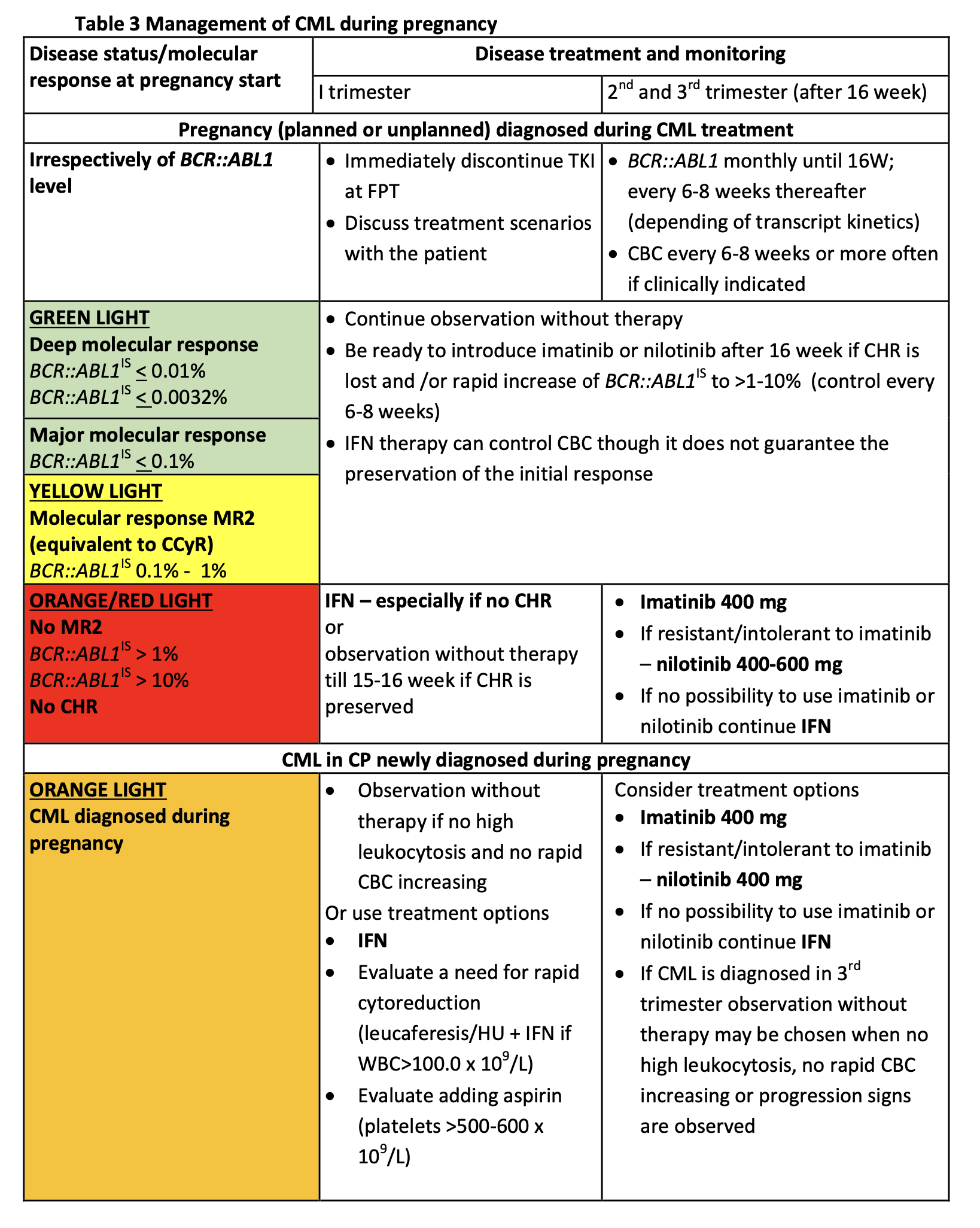

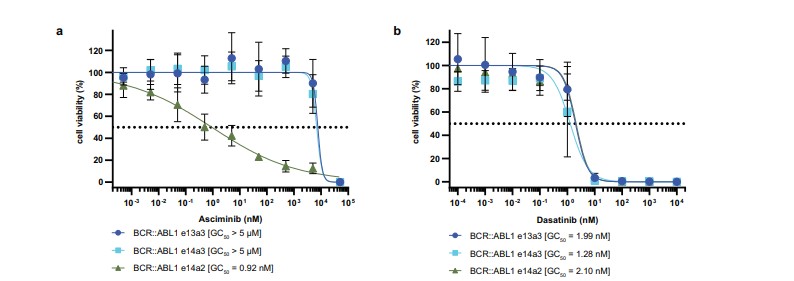
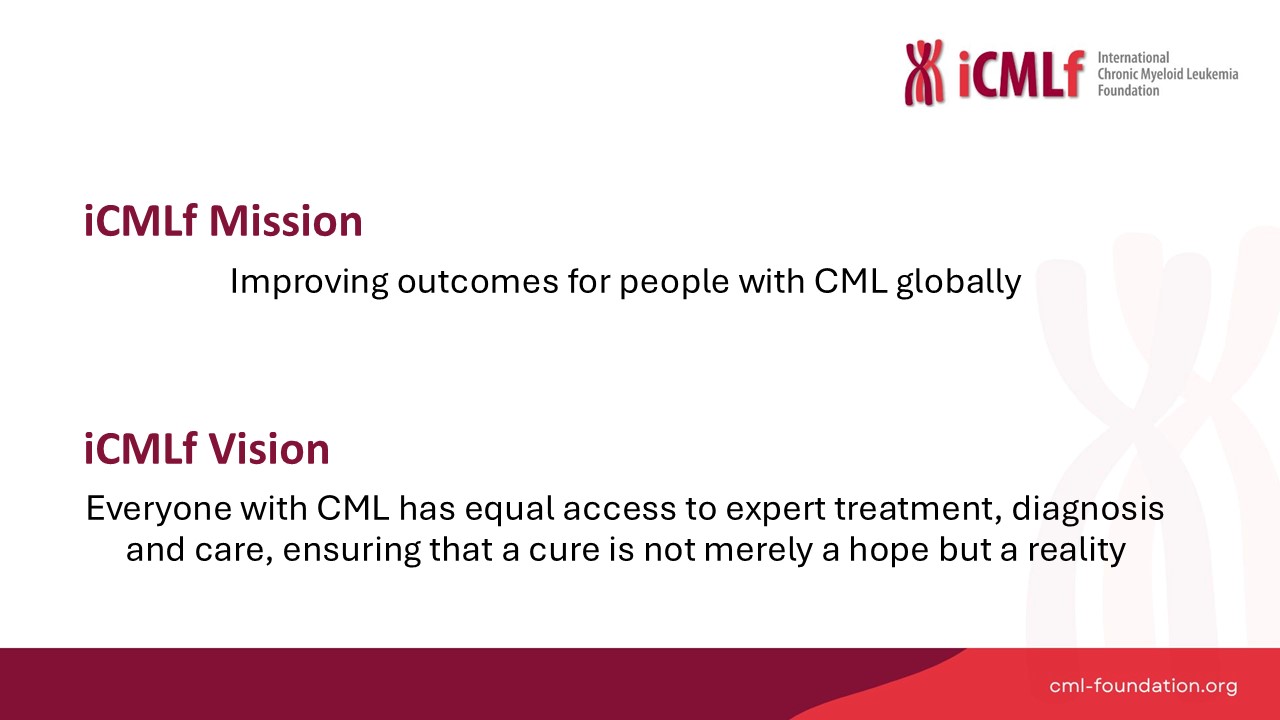 Session 1: The iCMLf – Planning for the future
Session 1: The iCMLf – Planning for the future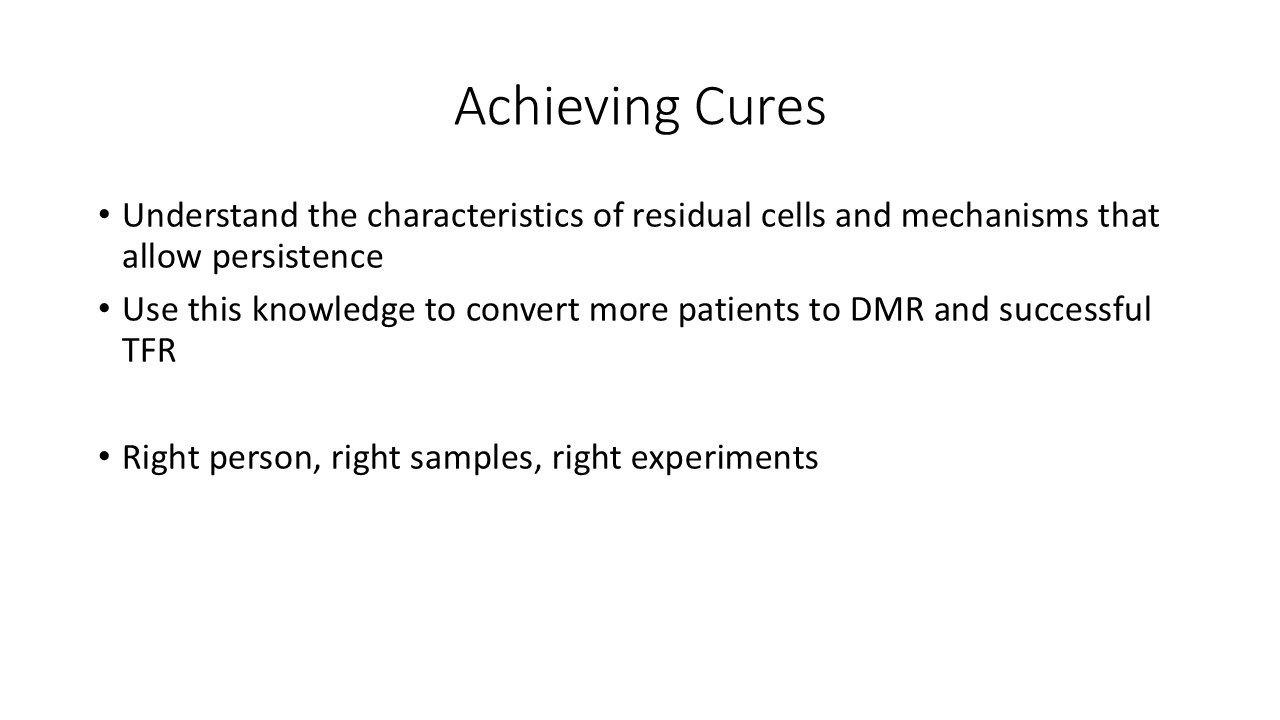 Presentation: Biological Barriers to Cure
Presentation: Biological Barriers to Cure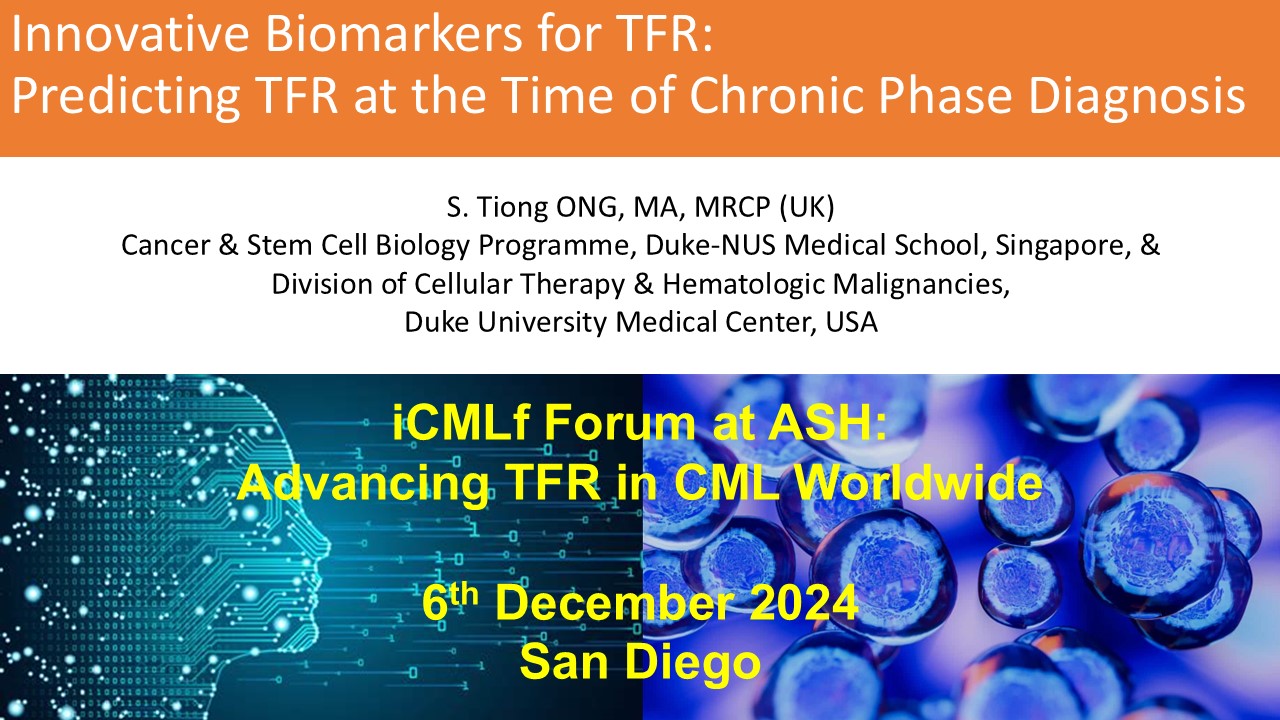
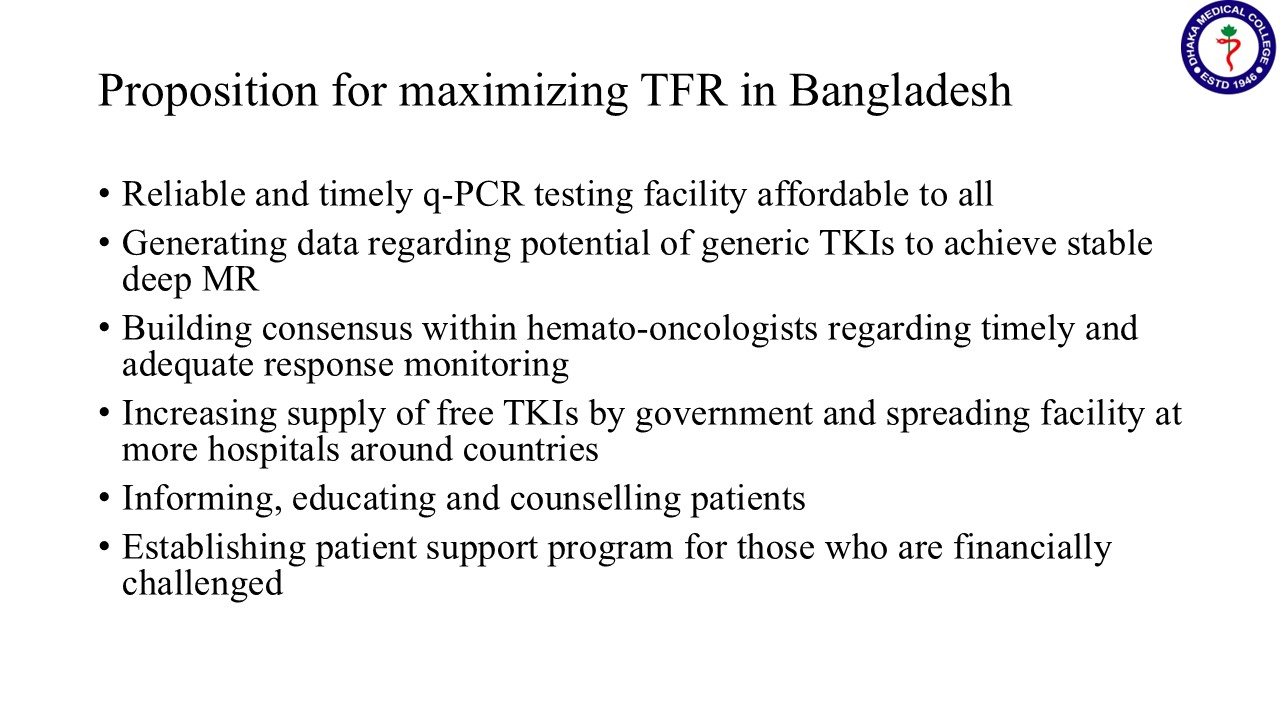 Presentation: TFR in Low-and-Middle-Income Countries
Presentation: TFR in Low-and-Middle-Income Countries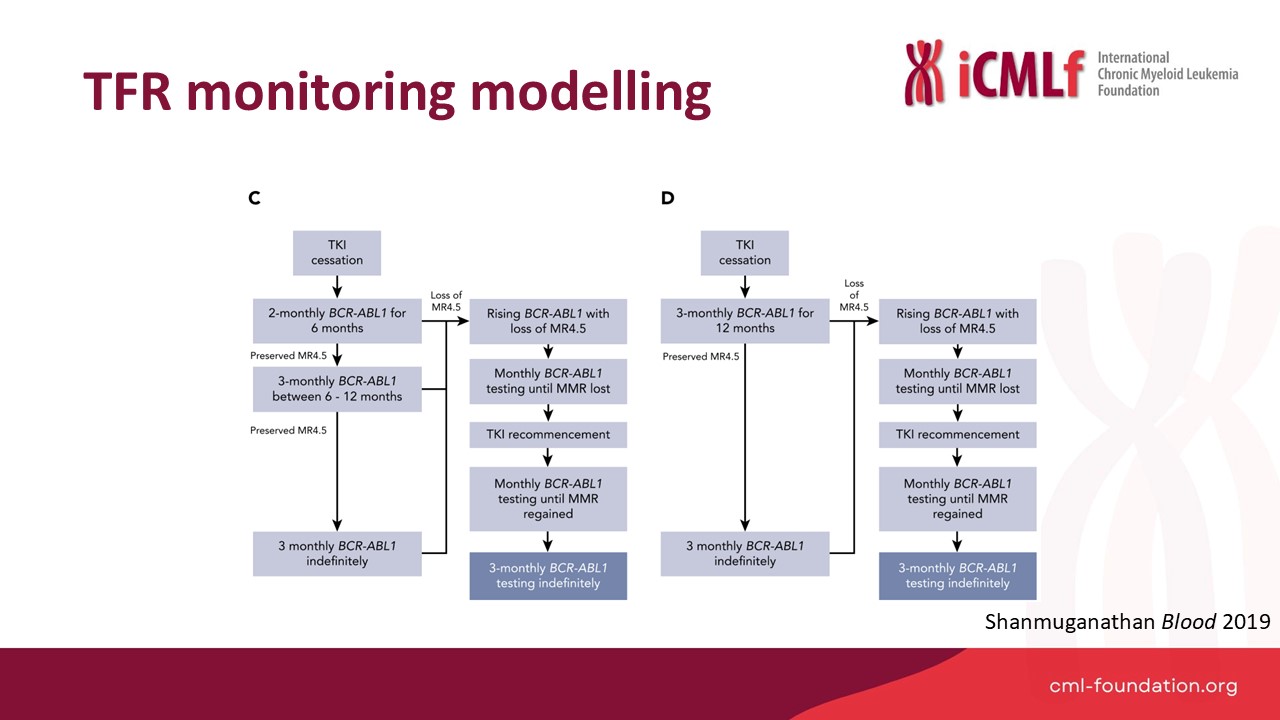 Presentation: Optimal TFR Monitoring
Presentation: Optimal TFR Monitoring 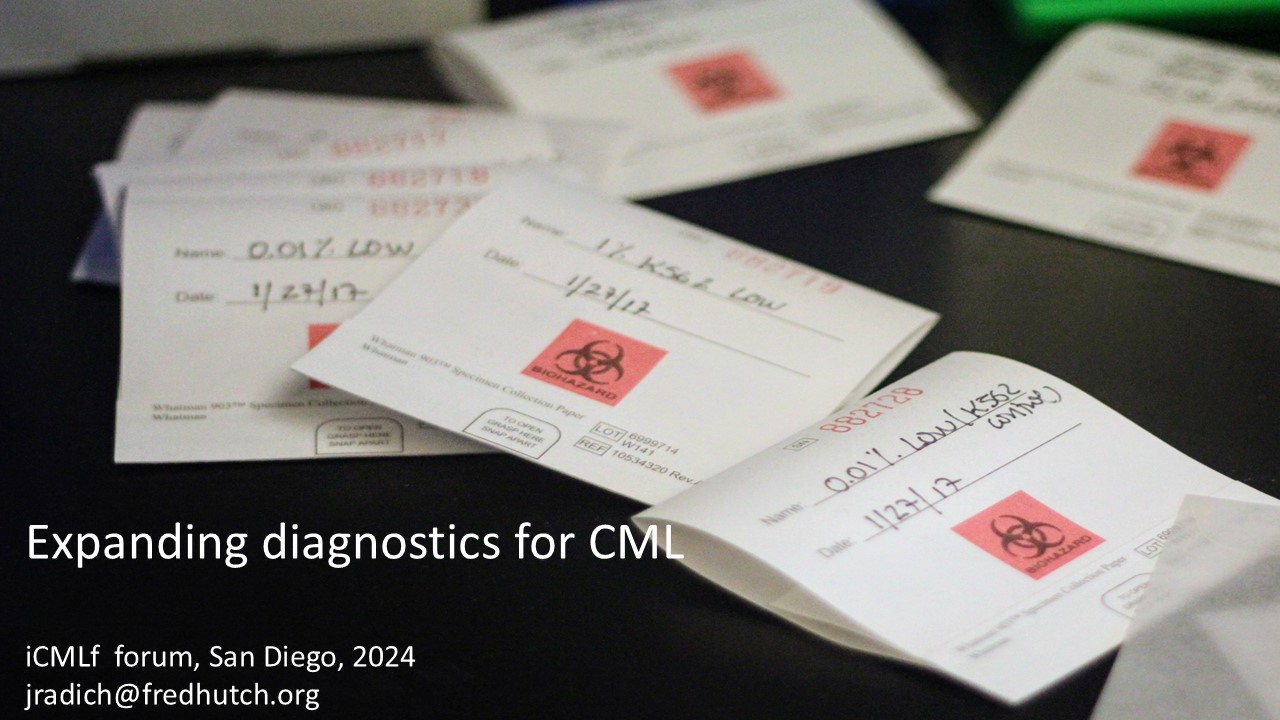 Presentation: Expanding Diagnostics for CML
Presentation: Expanding Diagnostics for CML









